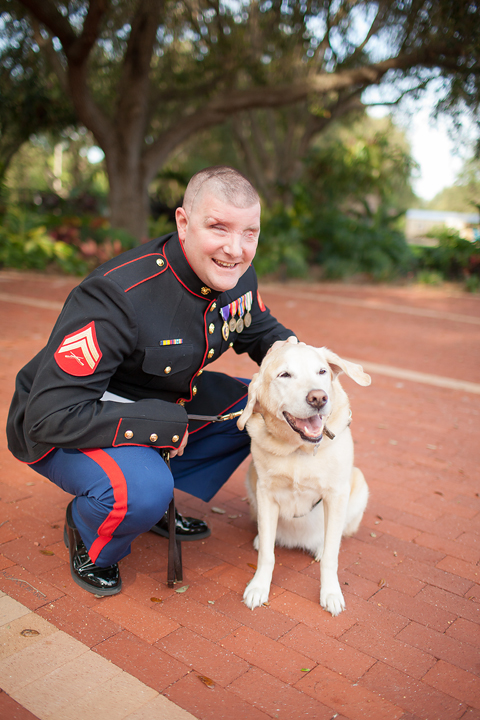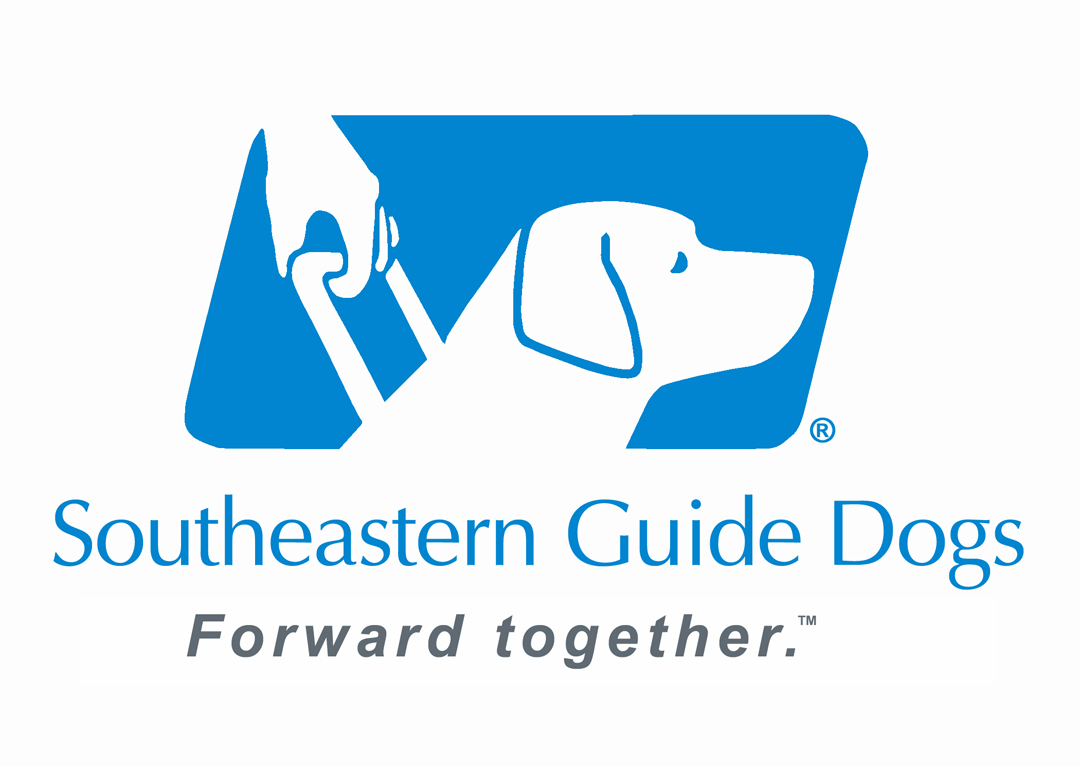
Michael Jernigan, who lost his eyes in a roadside bomb explosion in Iraq in 2004, with his guide dog Brittani. He says Southeastern Guide Dogs ‘will never charge any one of our students for a dog, not even a dollar. We’re here to help our community. That’s what we want to do.’
If we embrace the maxim that “A dog is a man’s best friend”—and around here, as you might imagine, we embrace it with a vengeance—then the dogs in the Paws For Patriots program surely represent the very best of those best friends.
Paws For Patriots was started in early 2006 at Southeastern Guide Dogs–a non-profit school based in Palmetto, Florida, that has provided guide dogs to people with visual impairments for more than three decades—aiming to fulfill a variety of needs experienced by active duty soldiers and veterans.
Fittingly, perhaps, one of the people who helped create Paws For Patriots is a veteran, Michael Jernigan, a Southeastern Guide Dogs staffer who joined me in studio for a Talking Animals conversation on February 13, alongside fellow staffer Judy Bordignon.
Judy Bordignon and Michael Jernigan, from Southeastern Guide Dogs, visit NPR’s Talking Animals to talk with host Duncan Strauss about the organization’s work, for more than three decades, providing guide dogs to people with visual impairments, with a special focus on fulfilling a variety of needs experienced by active duty soldiers and veterans via Paws for Patriots. Video by Libby Boosalis.
By way of recounting the program’s birth, Jernigan provided a bit of personal history.
“I was wounded by a roadside bomb in Iraq in August of 2004,” Jernigan recalls. “Among my various wounds, I lost both of my eyes. I was contacted by one of the board members at Southeastern Guide Dogs, who wanted to help. He called my mom and said ‘We’re here, we want to help your son, if and when he’s ready.’
“From there, I continued to go through surgeries and when I finally got out of the Marine Corps, I came down to Southeastern Guide Dogs in January of 2006, and we launched Paws For Patriots.
“It originally started as just a small program within Southeastern Guide Dogs, to help place guide dogs with blind and visually impaired veterans from our latest combat operations in Iraq and Afghanistan. And it’s a wildly popular program that has grown since then.”
Judy Bordignon explains what it takes to be a guide dog: “dogs that have to have the qualities of being able to connect with the veteran; they have to show a level of trainability; and even if they don’t meet that strict criteria of guide dog work, they still can learn commands that can help the veteran mitigate their experience of post-traumatic stress. Video by Libby Boosalis.
Jernigan went on to point out that initially, in pairing dogs with veterans, Paws For Patriots followed the protocol long in place at Southeastern. So the template was the same, but the clients clearly were not.
“One of the things that we did for Paws For Patriots is identified a need for guide dogs in the veteran community,” Jernigan remembers, his own guide dog, Brittani, curled up at his feet.
“We had noticed that more veterans were coming back with visual impairments and blindness, and a lot of it had to do with blast injuries, multiple blast injuries. I was involved with three IEDs in just six months. And you get your bell rung every time. And one of the things that can happen is the long-term side effects can cause some visual impairment. We identified that and used some processes we already had in place at Southeastern Guide Dogs for many years, to aid these veterans.”
Judy Bordignon and Michael Jernigan of Southeastern Guide Dogs talk about the dogs and what they do. In a fascinating anecdote, Jernigan, who lost both his eyes in a roadside bomb explosion in Iraq in 2004, explains how his guide dog Brittani has learned to anticipate his anxiety attacks and goes to his wife to alert her to an impending crisis. Video by Libby Boosalis.
Jernigan noted that the initial incarnation of Paws For Patriots quickly became highly popular, prompting him and his Southeastern colleagues to significantly broaden the pool of potential clients, enabling all veterans of all conflicts—of all ages—and experiencing visual impairment of any kind, to participate.
“And I think it was more recently, in just the last couple of years, we have opened up this veterans service dog program,” he says, passing the conversational baton to colleague Judy Bordignon, who’s been with Paws For Patriots since March of 2011.
“At Southeastern Guide Dogs, “ explains Bordignon, who oversees the training of the veteran service dogs, “the primary focus is to develop world class guide dogs. But not all dogs are cut out for the job–not every dog has the strict qualifications that are required to be a guide dog. So those dogs would then be assessed for other career possibilities, as responsible stewards of our most valuable resources, which is our dogs. For those who don’t make it as guide dogs, we want to consider other ways that these dogs can help the community.
Judy Bordignon and Michael Jernigan discuss the training of dogs to be veterans’ service dogs, and how some wash out of that role but are qualified for law enforcement or security work. Video by Libby Boosalis.
“And one option that became very obvious was helping to develop these dogs further to assist the veterans who are coming back from combat, diagnosed with post traumatic stress [disorder]. So the dogs that are assessed and deemed suitable for the veterans service dog program are dogs that have to have the qualities of being able to connect with the veteran, they have to show a level of train-ability. And even if they don’t meet that strict criteria, they still can learn commands that can help the veteran mitigate their experience of post-traumatic stress.
The key commands those dogs learn are uniquely geared for struggles faced by veterans contending with post traumatic stress disorder (PTSD), designed to open up what’s often a very narrow world, often marked by feeling deeply uncomfortable amidst crowds and hamstrung by the attendant self-imposed limitations of going grocery shopping or running other basic errands in the middle of the night. Or not going at all.
“We train them in specific commands—there are specific commands we teach these dogs that help define the personal boundary for these veterans,” Bordignon says. “For someone who’s experiencing post-traumatic stress, people invading their personal space is often a big deal. So we teach the dogs a series of commands that help define that personal boundary.
“One of those commands is ‘block’: where the dog will position itself between the veteran and anyone who’s coming in front of them. And that veteran can utilize that to create a distance, and maintain that space around them. Another command we teach is ‘watch’: where the dog will literally go to the veteran’s side, when commanded, and look behind them
Judy Bordignon and Michael Jernigan explain the training of veterans’ guide dogs and the donor financing of Southeastern Guide Dogs’ services. Video by Libby Boosalis.
“Now these are not guard dogs, they’re not going to growl if someone comes up from behind them. But they’ll signal by wagging their tail, doing that little dog shimmy that a friendly dog will do, or perk their ears up. So the veteran, instead of feeling like they always have to watch their back, to see who’s coming behind them, they can check out at the grocery store, or get an item off the grocery shelf and have the dog in the “watch” position.
“And when the dogs signals that someone is coming behind them, the veteran has options to stay safe. And sometimes, those signals are enough to get that individual [outside at various times], instead of going to the store at three in the morning.
Still, while the support of a carefully trained dog might enable a veteran with PTSD to venture out to the supermarket, the airport or other locales bearing throngs of fellow humans, that canine companion hardly constitutes an ironclad guarantee against the vet being smacked by a crippling wave of anxiety.
An introduction to the Southeastern Guide Dogs program
Indeed, when these folks are out and about, there are any number of sensory factors that can trigger not only profound angst, but also a full-fledged flashback. Here, too, these dogs can save the day, applying the emotional balm necessary to return the vets to an even keel.
“When they have flashbacks,” Bordignon says, “something triggers them–a smell, a sound, a voice, might trigger a flashback to their combat experience. The dog itself can serve as a grounding place. The dog will nudge them, they can bend down and touch the dog.
“One command we give them is that they can tap their shoulders if they feel overwhelmed by a crowd or an experience that they’re in, and tell the dog, ‘hug.’ People think that’s a feel-good command, but it’s really not. It’s a grounding command, that when they hold on to that dog, they’re in the present, and they can just exhale and hold on until that moment passes.”
Clearly speaking from personal experience, Jernigan interjects, “What winds up happening in that situation is that you start concentrating on that dog…you feel the dog’s fur, you feel the dog’s heartbeat. It re-focuses your attention off the stress and anxiety that a person might be experiencing, and onto the contact with that animal. Which then allows that stress and anxiety to dissipate.”
How could these dogs not sound magical? They’re best friend, protector and shrink rolled into the body of a retriever—there’s somehow even more magic to the Paws For Patriots story: While Jernigan and Bordignon estimate it costs Southeastern Guide Dogs about $40, 000 to produce a veteran service dog team–$60, 000 for a full-fledged guide dog team–the veterans and other students of the school do not pay a cent.
A short documentary focuses on Southeastern Guide Dogs’ trainers and training—dogs and humans alike
Sure, once they go home with the dog they’ve been paired with, the veterans are responsible for food, veterinary care and the other ongoing expenses that anyone would expect to absorb when living with a pet. But that’s it. The costs of breeding, raising, feeding, training and otherwise preparing the dogs for this work are underwritten by private donors, organizations, corporations and other sources of funding. Southeastern Guide Dogs is a 501 (c) (3) nonprofit organization that accepts donations and other means of support at its website: www.GuideDogs.org
When I enthuse on-air about Southeastern’s form of largesse, mentioning that some people who’d heard about this interview beforehand related tales of such service dogs from other organizations being financially out of reach for friends and family members—and that, when involved, insurance companies often balked at covering such costs—Jernigan seems taken aback to hear there’d be an economic barrier to veterans (or anyone, really) receiving this kind of help.
“We will never charge any one of our students for a dog, not even a dollar, “ he said emphatically. “We’re not going to say, ‘to get one of our dogs, you have to give us X amount of dollars.’ That’s not what we want to do in our community. We’re here to help our community. That’s what we want to do.”
And, boy, are they doing it.
Click here to listen to the complete Talking Animals interview with Michael Jernigan & Judy Bordignon.


